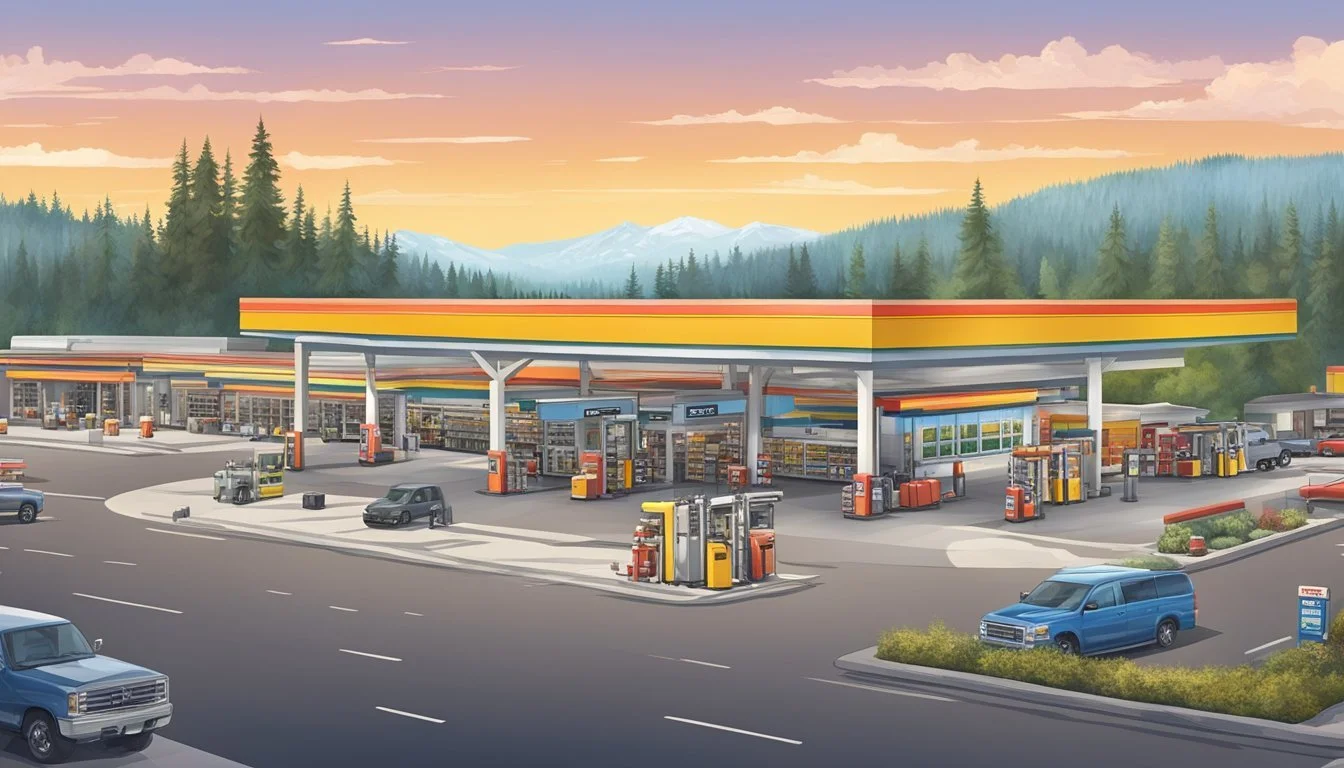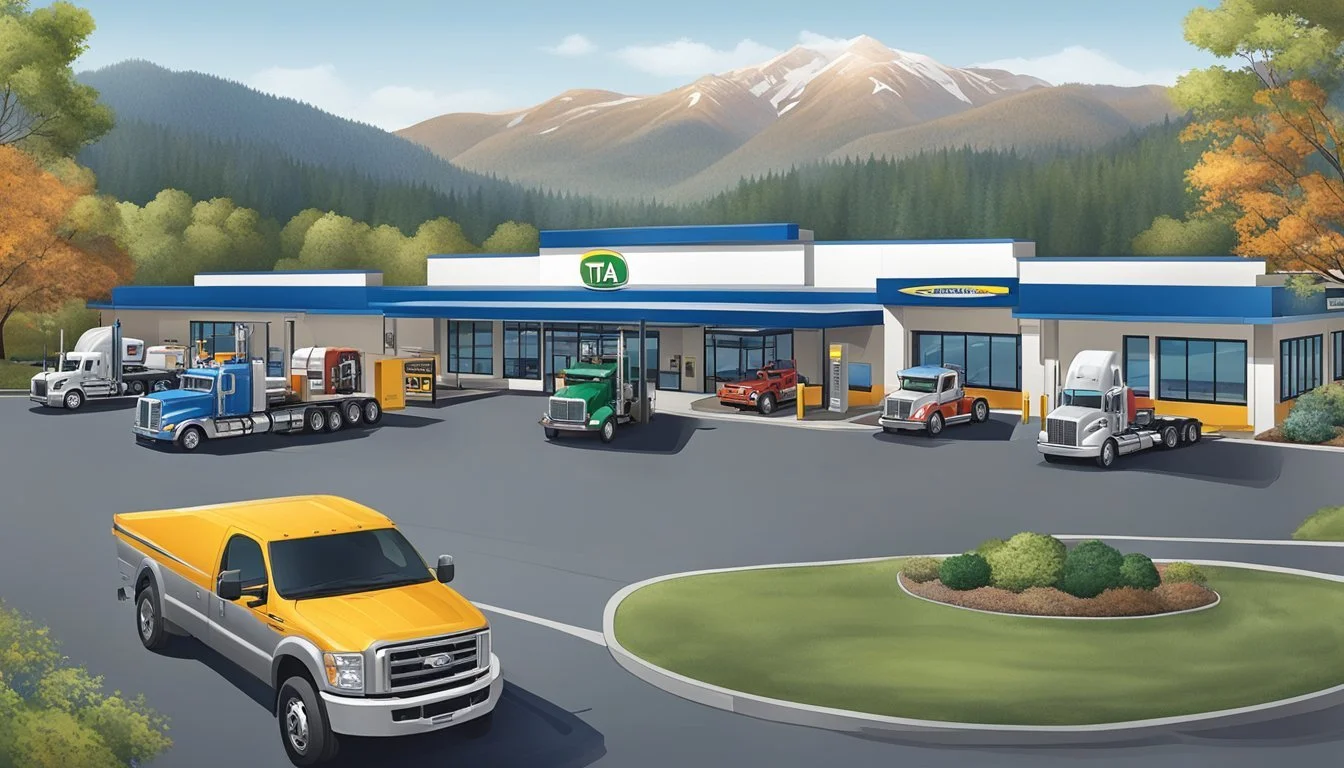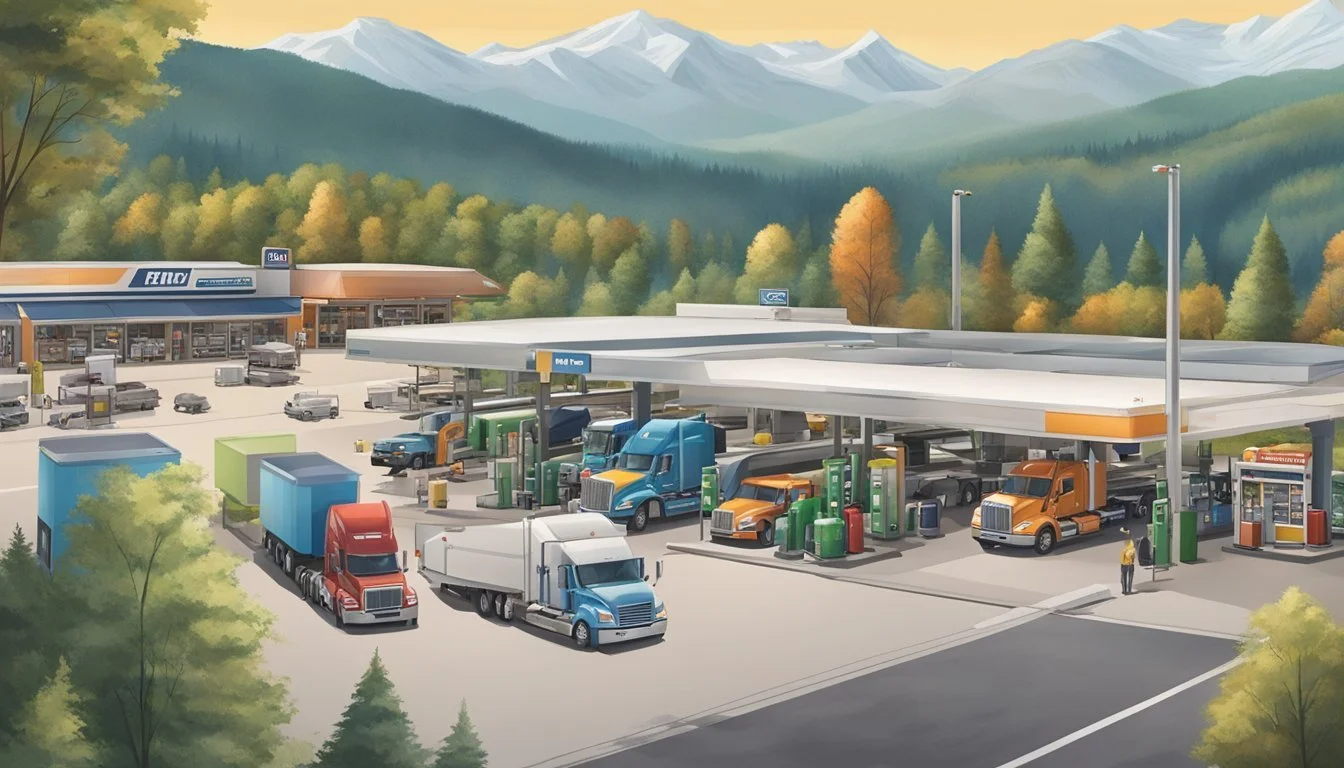Keith Hunter Jesperson: 8 Truck Stops That Played a Role in the Happy Face Killer's Crimes
A Chilling Cross-Country Trail
Keith Hunter Jesperson, known as the "Happy Face Killer," terrorized the United States in the early 1990s. This Canadian-American long-haul trucker murdered at least eight women across multiple states, targeting sex workers and transients he encountered on his routes. Jesperson gained notoriety for sending taunting letters to the media and authorities, signed with smiley faces.
Truck stops played a significant role in Jesperson's crimes, serving as hunting grounds where he found vulnerable victims. These locations, scattered across the country, became critical points in the Happy Face Killer's murderous journey. By examining eight specific truck stops connected to Jesperson's activities, we can gain insight into the patterns and methods of this notorious serial killer.
1) Pilot Travel Center, Port Angeles, WA
The Pilot Travel Center in Port Angeles, Washington played a significant role in Keith Hunter Jesperson's criminal activities. This truck stop, located in the Olympic Peninsula, served as a frequent stopping point for Jesperson during his long-haul trucking routes.
Port Angeles, situated on the northern coast of Washington state, provided Jesperson with access to both urban and rural areas. The travel center's proximity to major highways made it an ideal location for the serial killer to blend in with other truckers and travelers.
At this truck stop, Jesperson would often rest, refuel, and potentially scout for potential victims. The transient nature of truck stops allowed him to maintain anonymity while observing vulnerable individuals who might be traveling alone or seeking rides.
The Pilot Travel Center's 24-hour operation also provided Jesperson with opportunities to move undetected at various times of day or night. This facility, like many truck stops, offered services such as showers, laundry, and food, enabling him to maintain his appearance and routine while continuing his criminal activities.
2) Flying J Travel Plaza, Portland, OR
The Flying J Travel Plaza in Portland, Oregon played a significant role in Keith Hunter Jesperson's criminal activities. This truck stop served as a frequent stopping point for Jesperson during his long-haul trucking routes.
Located near major highways, the Flying J provided Jesperson with opportunities to target potential victims. The busy nature of the truck stop allowed him to blend in among other drivers and travelers passing through.
Jesperson likely used the facilities at Flying J to clean up after his crimes. The truck stop's showers, laundry services, and general amenities would have been useful for maintaining his appearance and avoiding suspicion.
The Portland Flying J also represented a connection to Jesperson's home base. As an Oregon resident, he was familiar with the area and could navigate it easily, increasing his comfort in carrying out his criminal acts nearby.
Law enforcement later focused on this location during their investigation into Jesperson's crimes. They sought to piece together his movements and identify potential witnesses who may have seen him at the truck stop.
3) Love's Travel Stop, Albany, OR
Love's Travel Stop in Albany, Oregon was a significant location in Keith Hunter Jesperson's criminal activities. This truck stop, situated along Interstate 5, provided Jesperson with opportunities to target potential victims.
As a long-haul trucker, Jesperson frequently visited Love's Travel Stop during his routes. The facility's amenities, including showers, food, and fuel, made it a popular spot for truckers passing through the area.
In the early 1990s, Jesperson encountered one of his victims at this location. He later confessed to meeting the woman at the truck stop before committing his heinous act.
The Love's Travel Stop in Albany serves as a chilling reminder of how Jesperson used his profession and these common trucking facilities to carry out his crimes. It highlights the vulnerability of individuals in transit and the importance of safety measures at such locations.
Law enforcement agencies have since increased their focus on truck stops as potential sites for criminal activity. This case has led to improved security protocols and awareness campaigns at similar facilities across the country.
4) TA Travel Center, Medford, OR
The TA Travel Center in Medford, Oregon played a role in Keith Hunter Jesperson's criminal activities during the 1990s. This truck stop, located along Interstate 5, served as a frequent stopping point for Jesperson during his long-haul trucking routes.
Jesperson often used truck stops like this one to target potential victims. The transient nature of these locations made them ideal for predators seeking anonymity and easy access to vulnerable individuals.
While specific details of Jesperson's activities at this particular truck stop are limited, it fits the pattern of locations he frequented during his killing spree. The TA Travel Center provided essential services for truck drivers, including fuel, food, and rest areas.
Law enforcement investigations later focused on truck stops along Jesperson's known routes. These locations became crucial in piecing together his movements and potential crime scenes.
The TA Travel Center in Medford serves as a stark reminder of how seemingly ordinary places can be connected to extraordinary crimes. It underscores the importance of vigilance and safety awareness in public spaces.
5) Petro Stopping Center, Spokane, WA
The Petro Stopping Center in Spokane, Washington, played a role in Keith Hunter Jesperson's criminal activities. This truck stop, located along Interstate 90, was a frequent stopping point for long-haul truckers traveling through the Pacific Northwest.
Jesperson, known as the "Happy Face Killer," often targeted women he encountered at truck stops. The Spokane Petro Stopping Center provided him with opportunities to find potential victims.
During his killing spree in the early 1990s, Jesperson visited this truck stop multiple times. He used the location to rest, refuel, and scout for women who might be vulnerable to his predatory behavior.
The facility's amenities, including showers, a restaurant, and a parking lot for overnight stays, allowed Jesperson to blend in with other truckers. This made it easier for him to operate without arousing suspicion.
While specific details about crimes committed at this location are limited, the Petro Stopping Center in Spokane remains significant in the narrative of Jesperson's criminal activities. It serves as a reminder of how truck stops factored into his modus operandi.
6) Flying J Travel Center, Seattle, WA
The Flying J Travel Center in Seattle, Washington, played a role in Keith Hunter Jesperson's crime spree during the early 1990s. This truck stop, like others frequented by Jesperson, provided a convenient location for the serial killer to target potential victims.
As a long-haul trucker, Jesperson often stopped at facilities like Flying J to rest, refuel, and seek out women who might be vulnerable to his predatory tactics. The bustling environment of truck stops offered ample opportunities for Jesperson to blend in and avoid suspicion.
While specific details about Jesperson's activities at this particular Flying J are limited, it's known that he utilized similar locations across multiple states to carry out his crimes. The Seattle area was within his operating range as he traveled along Interstate 5.
Jesperson's pattern of targeting women at truck stops and rest areas made these locations crucial to his ability to commit murders across state lines. The Flying J in Seattle, like other stops on his route, potentially served as a hunting ground for the man who would become known as the Happy Face Killer.
7) Love's Travel Stop, Tumwater, WA
Love's Travel Stop in Tumwater, Washington, became part of the dark narrative surrounding Keith Hunter Jesperson's crimes. This truck stop, like others along his route, provided a hunting ground for the serial killer known as the "Happy Face Killer."
Jesperson, a long-haul truck driver, frequented such locations during his cross-country journeys. These stops offered him opportunities to encounter potential victims, often women who were vulnerable or involved in high-risk lifestyles.
The Tumwater Love's Travel Stop, situated along Interstate 5, was a common refueling point for truckers. Its location near the state capital of Olympia made it a busy hub for travelers and locals alike.
While specific details about Jesperson's activities at this particular stop remain unclear, it fits the pattern of locations he utilized during his crime spree. Truck stops provided anonymity and transient populations, factors that Jesperson exploited in his murders.
Law enforcement investigations later connected the dots between various truck stops and Jesperson's crimes, highlighting the role these locations played in his ability to evade detection for years.
8) Pacific Pride Commercial Fueling, Portland, OR
Keith Hunter Jesperson frequently visited Pacific Pride Commercial Fueling in Portland, Oregon during his trucking career. This fueling station served as a regular stop for Jesperson to refuel his semi-truck and take breaks from long hauls.
The location's proximity to major highways made it a convenient spot for truckers passing through the Pacific Northwest. Jesperson likely used this fueling station as a staging area for some of his criminal activities in the region.
While no confirmed murders took place at this specific location, it played a role in Jesperson's overall pattern of movement. The station's 24-hour operation allowed him to come and go at odd hours without arousing suspicion.
Law enforcement investigators later examined records from Pacific Pride Commercial Fueling as part of their efforts to track Jesperson's movements. These fuel receipts and transaction logs helped piece together his travel patterns during the period of his crimes.
The fueling station continues to operate today, serving truckers and commercial vehicles in the Portland area. It remains a somber reminder of how Jesperson used the trucking industry to facilitate his crimes across multiple states.
Background of Keith Hunter Jesperson
Keith Hunter Jesperson, known as the "Happy Face Killer," was a Canadian-American serial killer active in the early 1990s. His criminal activities spanned multiple states and left a trail of victims in his wake.
Early Life and Career
Keith Hunter Jesperson was born on April 6, 1955, in British Columbia, Canada. He grew up in a troubled household and faced difficulties in his youth. As an adult, Jesperson pursued a career as a long-haul truck driver.
This profession allowed him to travel extensively across the United States. His job provided him with the mobility and anonymity that would later facilitate his criminal activities.
Criminal Activities and Modus Operandi
Between 1990 and 1995, Jesperson committed at least eight murders, primarily targeting women. His victims were often found near truck stops or highways, aligning with his profession as a truck driver.
Jesperson gained notoriety for sending confession letters to media outlets and authorities. These letters were signed with a distinctive smiley face, earning him the moniker "Happy Face Killer."
His criminal spree spanned multiple states, making it challenging for law enforcement to connect the crimes initially. Jesperson's modus operandi involved strangling his victims, a method he employed consistently throughout his killing spree.
Investigative Techniques Used
Forensic evidence and multi-agency collaboration were crucial in solving the Happy Face Killer case. These methods helped investigators piece together clues and track Jesperson's movements across state lines.
Forensic Evidence
DNA analysis played a key role in linking Jesperson to several crime scenes. Investigators collected biological samples from victims' bodies and personal belongings. These were compared to Jesperson's DNA profile, establishing connections to multiple murders.
Tire track and shoe print analysis also proved valuable. Forensic experts matched distinctive patterns from crime scenes to Jesperson's truck tires and footwear. This physical evidence placed him at multiple murder locations.
Handwriting analysis of Jesperson's confession letters provided another crucial link. Experts compared the letters to known samples of his writing, confirming their authenticity.
Law Enforcement Collaboration
The case required extensive cooperation between law enforcement agencies across multiple states. Task forces were formed to share information and coordinate efforts.
Investigators utilized truck stop surveillance footage and fuel receipts to track Jesperson's movements. This helped establish a timeline of his activities and potential victim encounters.
Interviews with other truck drivers and truck stop employees provided valuable leads. These witnesses often recalled interactions with Jesperson or his victims.
The FBI's Violent Criminal Apprehension Program (ViCAP) database was used to identify potential connections between seemingly unrelated murders. This tool helped investigators recognize Jesperson's pattern of crimes across state lines.











